Build airtight and save costs
The Ultimate Guide to Nearly Zero Energy Building
Download
Under new regulations all Irish buildings must be nearly zero energy buildings (NZEBs). But what exactly is an NZEB, and what is the role of airtightness in this new standard?
Few terms have been talked about more in the Irish building industry recently than NZEB. The moniker is on the tip of everyone’s tongue, but even though this new building standard came into force for new homes at the start of November, to what extent has the industry really gotten to grip with what it means?
The EU has mandated that all new buildings be NZEBs from the 31st of December 2020
You probably already know that NZEB stands for Nearly Zero Energy Buildings, a new benchmark from the European Union for very low operational energy use in both domestic and non-domestic buildings. Under the European Performance of Buildings Directive, the EU has mandated that all new buildings be NZEBs from the 31st of December 2020 (all publicly owned buildings, meanwhile, had to meet the standard from the end of 2018).
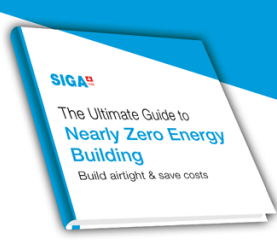
Unlike most building standards we are familiar with, the EU has not strictly defined what an NZEB is, allowing each member state to come up with its own definition. The European Commission has, however, recommend that for European countries in the “oceanic zone” — like Ireland — NZEB dwellings should consume a maximum of 50-65 kWh/m2/yr primary energy, with 35 kWh/m2/yr of this generated on site by renewable energy systems. For non-domestic buildings, the advice is for a maximum primary energy demand of 85 to 100 kWh/m2/yr with 45 kWh/m2/yr of this covered by renewables.
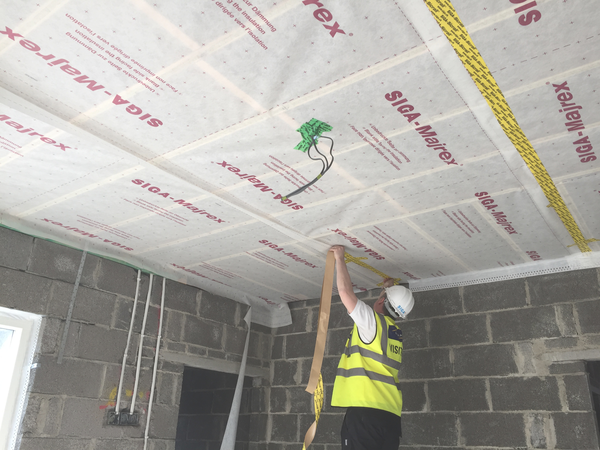
To bring Ireland in line with this requirement, the government has published new versions of Part L of the building regulations, and associated technical guidance documents, for both domestic and non-domestic buildings. These new regulations are now in force for all new buildings which receive planning permission (for dwellings since November 1; for non-domestic buildings since January).
In order to qualify as NZEB, dwellings should have a MPEPC no greater than 0.3
The technical guidance document to Part L (we’ll call it TGD L from here on) says that in order to qualify as an NZEB, dwellings should have a maximum permitted energy performance coefficient (MPEPC) no greater than 0.3, and a maximum permitted carbon performance coefficient (MPCPC) no great than 0.35.
The energy and carbon performance coefficients are figures calculated by the DEAP software that take into account a large number of factors influencing the energy efficiency and carbon emissions of a dwelling. They are referenced against the 2005 building regulations, which means that a dwelling with an energy performance co-efficient (EPC) of 0.3 should theoretically consume 30% of the energy of a dwelling built to the 2005 version of Part L. (The calculation is a little different for non-domestic buildings. The new version of Part L here requires buildings to use about 60% less energy than the previous (2009) version, while up to 20% of demand must be met my renewable energy.)
For dwellings, the new version of TGD L requires homes to be 25% more energy efficient than those built to the previous (2011) version, which allowed a maximum EPC of 0.4. Because the EPC takes into account a large numbers of factors, building designers have flexibility in the measures they take to ensure a dwelling complies with the standard.
However, there has also been a tightening up of the minimum ‘backstop’ U-values values allowed for key building elements in the new version of TGD L (see table). The renewable energy requirement has also changed from a minimum 10 kWh/m2/yr of renewable energy generation to a minimum percentage — namely at least 20% of a home’s energy demand must come from on-site renewables. But in this post we want to focus on the role of airtightness in the new regulations, and how achieving higher levels of airtightness can help you to meet NZEB.
| Column 1: Fabric Elements | Column 2: Area-weighted Average Elemental U-value (Um) |
|---|---|
| Pitched roof - insulation at ceiling | 0.16 |
| Pitched roof - inulation on slope | 0.16 |
| Flat roof | 0.20 |
| Walls | 0.18 |
| Ground floors | 0.18 |
| Other exposed floors | 0.18 |
| External doors, windows and rooflights | 1.40 |
Airtightness and Ventilation form the two sides of the same coin
The key thing to understand about the airtightness requirements in TGD L is that is that they are closely intertwined in the ventilation regulations in TGD F, which has also been updated to bring Ireland in line with NZEB. These essentially form two sides of the same coin. This is to ensure that, as buildings become more airtight, indoor air quality is protected.
In TGD L, 5 m3/hr/m2 is now the upper limit for air permeability — the worst airtightness test result a dwelling is allowed to achieve. The previous upper limit, in the 2011 regulations, was 7 m3/hr/m2.
The new version TGD F only provides guidance for installing natural ventilation (such as window trickle vents or the classic hit-and-miss wall vents common to many Irish homes) for dwellings with an air permeability between 3 m3/hr/m2 and 5 m3/hr/m2. This implies that only mechanical ventilation systems (such as heat recovery, whole house extract or demand controlled ventilation) are acceptable for homes with air permeability under 3 m3/hr/m2, in order to ensure indoor air quality.
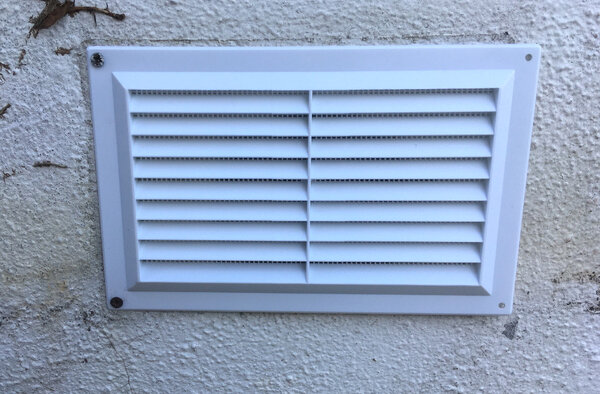
Technical guidance is no longer given for natural ventilation systems in dwellings with better airtightness than 3 m ³/hr/m ²
There are other important changes too since the previous regulations for dwellings. Now, for the first time ever, every single dwelling built in Ireland must undergo an airtightness test. This should help to ensure greater consistency and quality of workmanship on building sites across Ireland. Previously it was possible, on multi-unit housing schemes, to air-test a sample of dwellings and then use a default air permeability value of 7 m3/hr/m2 in DEAP for untested homes.
There will also now be a requirement for dwellings to undergo both pressurisation AND de-pressurisation tests for air permeability — a sensible step forward, because testing only one way or the other can give a slightly misleading result depending on whether a building features inward-opening or outward-opening windows.
There is also a new requirement for all non-domestic buildings to be air-tested, and for these to achieve a maximum air permeability of 5 m3/hr/m2.
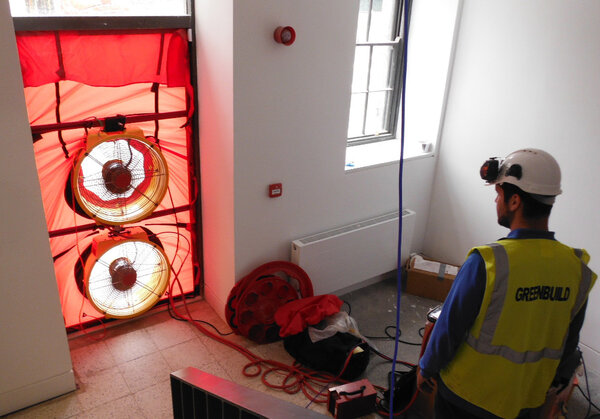
Blower door air permeability testing: there is now a requirement for Irish dwellings to undergo both pressurisation and de-pressurisation tests Photo: Greenbuild
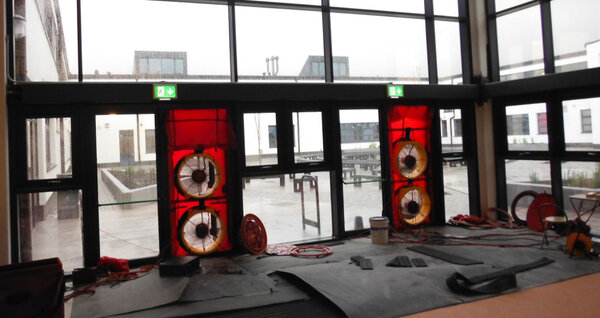
Photo: Greenbuild
So, for developers, designers and project managers, what sort of air permeability score should you aim for on your project? Is there any reason to aim for a score significantly better than the backstop values mandated by the regulations? To answer this question, it is worth looking at how much more airtight Irish homes have already become in recent times.
The Sustainable Energy Authority of Ireland’s unpublished 2005 Energy Performance Survey of Irish Housing, which looked at a sample of Irish housing build around the turn of the millennium, found that the average air permeability of dwellings surveyed was a shockingly poor 11.8 m3/hr/m2. By 2017, however, this had dramatically improved to an average of 3.66 m3/hr/m2, according to SEAI’s National BER Research Tool. In the first half of 2019, the average was down to 2.85 m3/hr/m2.
Our buildings are getting more airtight all the time, and these figures show that the Irish building industry has, for the past few years, been building to a higher standard than the 7.0 m3/hr/m2 required by the 2011 building regulations, and the 5.0 m3/hr/m2 mandated by the new NZEB rules. They are also representative of the fact that simply achieving the ‘backstop’ values is not enough to meet the regulations — you need to do significantly better than these, at least for some measures.
With a little practice, good design and attention to detail air permeability results can become straightforward and cost-effective
This is even more the case now that the maximum permitted EPC has been cut from 4.0 to 3.0. Airtightness is one of those areas where it makes the most sense to be ambitious — because with a little practice, good design and attention to detail on site, achieving world-class air permeability results can become relatively straightforward and cost-effective.
You can’t do airtightness in half-measures — either airtightness is designed into your project, and your team is organised and trained to deliver it on site, or it isn’t. If it isn’t, you might still meet your legal obligations, possibly because the typical blockwork-and-wet-plaster building method used in Ireland tends to deliver a certain degree of inherent airtightness anyway. But with building standards tightening all the time, this sort of ‘hope-for-the-best’ approach probably won’t cut it forever.

Lenny is a journalist who covers the environment and sustainability. He has been writing about the built environment for over a decade, and is deputy editor of the sustainable building magazine Passive House Plus.
Added to my cart